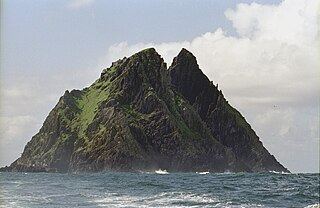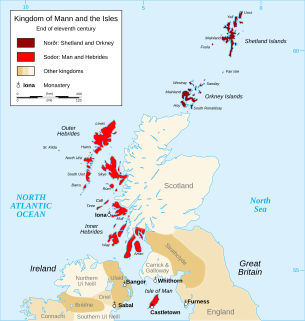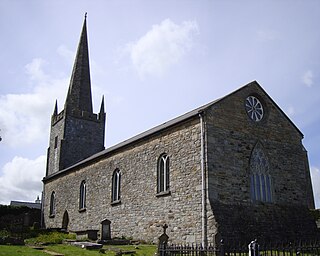
Lindisfarne, also called Holy Island, is a tidal island off the northeast coast of England, which constitutes the civil parish of Holy Island in Northumberland. Holy Island has a recorded history from the 6th century AD; it was an important centre of Celtic Christianity under Saints Aidan of Lindisfarne, Cuthbert, Eadfrith of Lindisfarne and Eadberht of Lindisfarne. After the Viking invasions and the Norman conquest of England, a priory was reestablished. A small castle was built on the island in 1550.

Skellig Michael, also called Great Skellig, is a twin-pinnacled crag 11.6 kilometres (7.2 mi) west of the Iveragh Peninsula in County Kerry, Ireland. The island is named after the archangel Michael, while "Skellig" is derived from the Irish language word sceilig, meaning a splinter of stone. Its twin island, Little Skellig, is smaller and inaccessible. The two islands rose c. 374–360 million years ago during a period of mountain formation, along with the MacGillycuddy's Reeks mountain range. Later, they were separated from the mainland by rising water levels.

The early medieval history of Ireland, often called Early Christian Ireland, spans the 5th to 8th centuries, from the gradual emergence out of the protohistoric period to the beginning of the Viking Age. The period notably includes the Hiberno-Scottish mission of Christianised Ireland to regions of pagan Great Britain and the spread of Irish cultural influence to Continental Europe.

Enniscrone – also spelt Inniscrone and officially named Inishcrone – is a small seaside town in County Sligo, Ireland. Its sandy beach, tourist campsite, and golf course all attract visitors. As of the 2016 census, the town had a population of 1,156 people.

Killala is a village in County Mayo in Ireland, north of Ballina. The railway line from Dublin to Ballina once extended to Killala. To the west of Killala is a Townsplots West, which contains a number of ancient forts.

Inishbofin is a small island off the coast of Connemara, County Galway, Ireland. Inishbofin has around 180 inhabitants and is a tourist destination.

Cainnech of Aghaboe (515/16–600), also known as Saint Canice in Ireland, Saint Kenneth in Scotland, Saint Kenny and in Latin Sanctus Canicus, was an Irish abbot, monastic founder, priest and missionary during the early medieval period. Cainnech is one of the Twelve Apostles of Ireland and preached Christianity across Ireland and to the Picts in Scotland. He wrote a commentary on the Gospels, which for centuries was known as the Glas-Choinnigh or Kenneth's Lock or the Chain of Cainnech.

Eileach an Naoimh, also known as Holy Isle, is an uninhabited island in the Inner Hebrides of the west coast of Scotland. It is the southernmost of the Garvellachs archipelago and lies in the Firth of Lorne between Mull and Argyll. The name is Gaelic for "rocky place of the saint".

The Norse–Gaels also known as Hiberno-Scandinavian were a people of mixed Gaelic and Norse ancestry and culture. They emerged in the Viking Age, when Vikings who settled in Ireland and in Scotland adopted Gaelic culture and intermarried with Gaels. The Norse–Gaels dominated much of the Irish Sea and Scottish Sea regions from the 9th to 12th centuries. They founded the Kingdom of the Isles, the Kingdom of Dublin, the Lordship of Galloway, and a Norse-Gaelic family briefly ruled the Kingdom of York. The most powerful Norse–Gaelic dynasty were the Uí Ímair or House of Ivar.

The Bishop of Killala is an episcopal title which takes its name after the village of Killala in County Mayo, Ireland. In the Roman Catholic Church it remains a separate title, but in the Church of Ireland it has been united with other bishoprics.
The Bishop of Achonry is an episcopal title which takes its name after the village of Achonry in County Sligo, Ireland. In the Roman Catholic Church it remains as a separate title, but in the Church of Ireland it has been united with other bishoprics.
Saint Fintán, or Munnu is one of the saints of Ireland and Britain who served in Ireland and Scotland being the founder and abbot of the abbey at Teach-Mhunn - The House of Saint Munn - where his bed may be visited is a pilgrimage site; today Taghmon is in the County Wexford, in the province of Leinster Ireland. In Scotland, he is venerated as the patron saint of Clan Campbell.
Ailbhe Mac Shamhráin was an Irish medieval historian and celticist.

Saint Muiredach mac Echdach, also known as Murtagh, was the founding Bishop of Killala, Ireland in the 6th century.

Nendrum Monastery was a Christian monastery on Mahee Island in Strangford Lough, County Down, Northern Ireland. Medieval records say it was founded in the 5th century, but this is uncertain. The monastery came to an end at some time between 974 and 1178, but its church served a parish until the site was abandoned in the 15th century. Some remains of the monastery can still be seen.

Inis Cealtra, also known in English as Inishcaltra or Holy Island, is an island off the western shore of Lough Derg in Ireland. Now uninhabited, it was once a monastic settlement. It has an Irish round tower, and the ruins of several small churches, as well as four high crosses and a holy well. Despite the lack of population, the cemetery on this island is still in use. Coffins and mourners are transported the short distance from County Clare in small boats. Boat trips can be taken from the harbour at Mountshannon. It is conserved by the East Clare Heritage Centre.

The Abbey River is a distributary arm of the River Shannon that flows around the northeastern, eastern, and southern shores of King's Island, Limerick before rejoining the Shannon at Hellsgate Island. Hellsgate Island is only visible at low tide. It is bridged by the Abbey Bridge, Baals Bridge, the Canal Bridge, Matthew Bridge, O'Dwyer Bridge, and the Sylvester O'Halloran Footbridge.

Inishkeel is a small tidal island and a townland off the coast of County Donegal, Ireland. The closest village on the mainland is Narin.

The Soiscél Molaisse is an Irish cumdach that originated from an 8th-century wooden core embellished in the 11th and 15th centuries with metal plates decorated in the Insular style. Until the late 18th century, the shrine held a now-lost companion text, presumed to be a small illuminated gospel book associated with Saint Laisrén mac Nad Froích, also known as Molaisse or "Mo Laisse". In the 6th century, Molaisse founded a church on Devenish Island in the southern part of Lough Erne in County Fermanagh, with which the cumdach is associated.



















